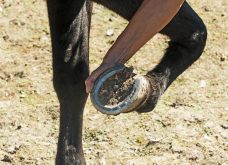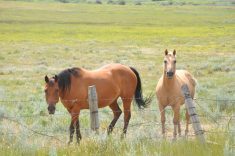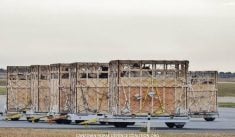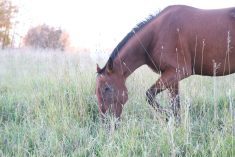Despite their remarkable strength and resiliency horses are highly susceptible to lameness under the circumstances of domestication.
In fact lameness is the most common symptom presented to the equine veterinarian. Almost every horse will experience some kind of lameness during its lifetime. Its diagnosis, treatment and collateral losses represent one of the most costly health problems for the equine industry.
Lameness itself is a nondescript term that characterizes the abnormal movement of a horse and this degree of abnormal movement exists on a spectrum. Obvious limping and non-weight bearing of one limb associated with a stone bruise or hoof abscess describes a lame horse yet the subtle change in gait or inability or unwillingness to perform also describes a lame or unsound horse.
Read Also

Pig transport stress costs pork sector
Popular livestock trailer designs also increase pig stress during transportation, hitting at meat quality, animal welfare and farm profit, Agriculture and Agri-Food Canada researcher says
Though often thought of as a problem of the feet or legs, lameness can and often does involve virtually any part of the horse’s body and its origins can have surprising roots. Not all lame horses are in pain, although many are. Some have a mechanical lameness as a result of scar tissue from a previous injury and some can have what appears to be a lameness due to a neurological disorder.
It is not uncommon to find multiple sites of “hurt” in a lame horse as a result of the body’s attempt to adapt and compensate. Veterinarians and equine therapists asked to second and even third opinion equine lameness will often discover and identify seemingly different sources of lameness. This may seem confusing and conflicting to the horse owners, however, in the majority of incidences all professional parties are correct and contributing a chapter to the lameness story. Due to the anatomical complexity and connectivity of the animal, a horse identified with a singular diagnosis for lameness is more of an exception than the rule. Horses commonly hurt in more than one site and that hurt can ping-pong between locations in the body and the site of the pain is not always where the problem begins.
Horses with a subtle lameness may demonstrate any number of behaviours that are easy to misconstrue as training or resistance issues. Horses are incredibly willing creatures and thus it is necessary to consider that the horse with a subtle lameness “may not” be able to do what is asked of it rather than “will not” do what is asked of it. Unfortunately many horses are asked to perform when they are in pain because of riders’ failure to recognize subtle physical unsoundness.
Many riders intuitively know when something’s not quite right with their horse’s gait or way of going — even if it is hard to articulate exactly what is being felt or seen. The more subtle lamenesses can be very challenging to characterize and language. The horse may not look lame but there will be important clues in its history that warrant investigation and a deeper dive into matters. The horse may feel “off” or isn’t smooth when ridden. The horse may show uncharacteristic behaviour upon tacking up.
Maybe the horse suddenly is reluctant to pick up a lead or perform more demanding manoeuvres. The nature of the lameness, although subtle may wax and wane depending on footing surfaces and 10-metre circles. Upon occasion a horse’s lameness may only be evident when ridden and in some of these horses lameness only occurs with a certain rider — horse combination. These complaints seem vague yet they are valid and useful observations when it comes to investigating unsoundness. If a horse doesn’t “feel right” to its rider, the horse probably is not right. As such, riders can play a vital role as first responders in lameness investigations.
With the exception of a sudden injury, equine lameness rarely “just happens.” Horses often “go lame” over a period of time and thus it is useful to understand the many factors that contribute to the evolvement of lameness in the horse.
Horses are “going lame” if they are overburdened when they are physically and mentally immature, have weak conformation, have improper hoof balance, are inadequately conditioned, undergo monotonous repetitive exercising, worked on hard, slippery, or deep footing surfaces, worked and exhausted to the point of fatigue with disregard for rest or turnout periods. The value of these causes cannot be overemphasized because this is where the best interests and highest welfare for the horse exist, and understanding their contributions to unsoundness is time well invested.
When thoroughly investigated lamenesses have the potential to expose weakness in husbandry practices.
For example, certain types of lamenesses can be ascribed to inappropriate diets and dietary practices which lead to poor hoof quality, tender feet, laminitis and digestive disturbances. Horses with gastrointestinal ulceration will commonly “appear” lame and resistant to movement as they struggle with their abdominal discomfort.
Dental arcade imbalances and pain in the mouth translates into muscular tension along the top line and quickly sets the stage for the appearance of secondary lameness as the kinematics of the legs are altered. Quality dental work can be instrumental in dissolving subtle lamenesses. Trailering and travel for the horse may be responsible for muscle soreness, fatigue and dietary disruptions and can cause, contribute to and/or compound lameness issues.
The interactions between horse and rider are important, but not always easy to follow. Yet there is a growing body of information implicating that the abilities of the rider to influence the movement of the horse and its body carriage are crucial to developing the horse’s body properly and meeting the athletic demands that will be asked of it. Ill-fitting tack, especially but not limited to the saddle, often goes unrecognized for its contribution to the development of lamenesses in horses.
Although many horses cope well enough with all kinds of lamenesses their quality of life would greatly improve if the underlying nature and roots for their “kind” of lameness were thoroughly understood and addressed. The best way to approach this work is by stepping back and seeing and listening to the whole horse.




















